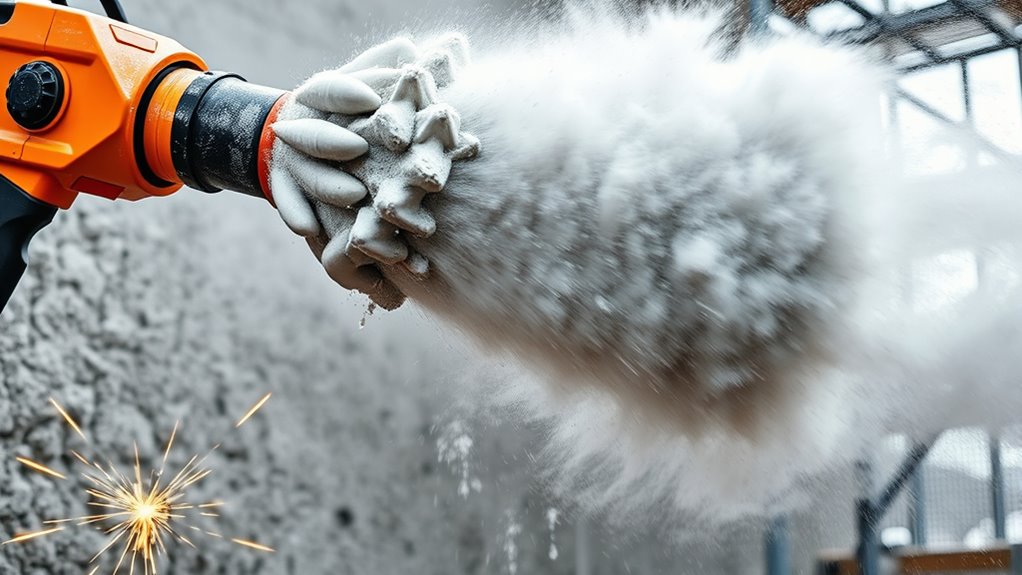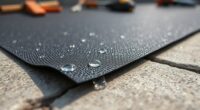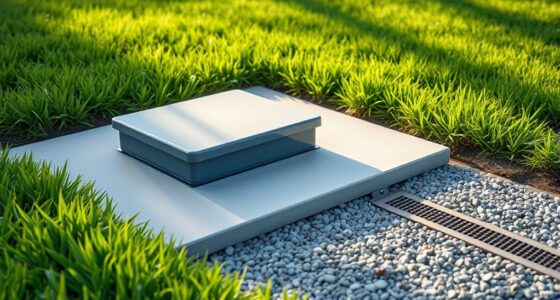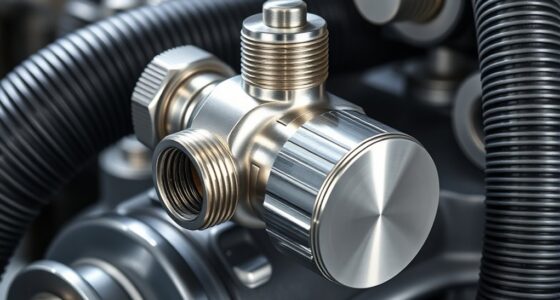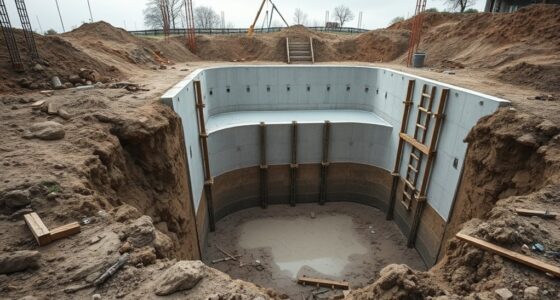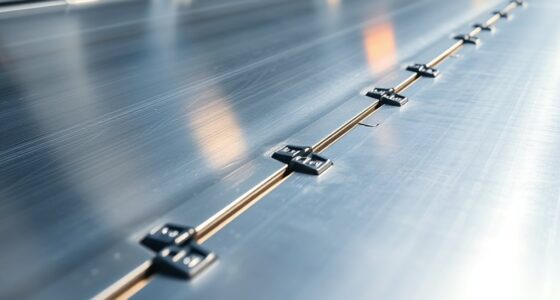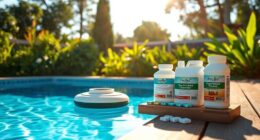Shotcrete and gunite are both sprayed concrete methods but differ mainly in application and mix. Gunite uses a dry mix with water added during spraying, requiring skilled operators and precise handling. Shotcrete typically mixes water beforehand, allowing for faster, more controlled application with additives that enhance durability. If you want to understand which suits your project best, you’ll find more details on their origins, uses, and benefits as you explore further.
Key Takeaways
- Shotcrete typically uses pre-mixed or wet mixes, while gunite employs a dry-mix process with water added at the nozzle.
- Shotcrete is pneumatically sprayed with advanced equipment, allowing for faster, more precise application compared to gunite’s manual spraying.
- Both materials provide strong adhesion and durability, but shotcrete bonds more densely and is better suited for complex geometries.
- Gunite is often more labor-intensive and costly due to specialized equipment and on-site mixing; shotcrete generally offers quicker, cost-effective application.
- Industry standards like ASTM C1140 and ACI 506R govern both, but shotcrete’s modern techniques often ensure higher quality and consistency.
Historical Background and Origins of Shotcrete and Gunite

While shotcrete and gunite are often used interchangeably today, their origins and development tell different stories. Gunite was developed in the early 1900s by Carl A. Buck in California, initially used for repairing structures and swimming pools. It’s a dry-mix process that requires water addition at the nozzle. Shotcrete, on the other hand, emerged in the 1930s, evolving from gunite technology, and was popularized by the U.S. Army for rapid construction and military applications. Shotcrete’s development focused on improving versatility and application methods, leading to its use in tunnels, dams, and more complex structures. These distinct origins highlight how each technique adapted to specific needs and technological advances over time. Despite their similarities, their histories reveal different paths of innovation.
Composition and Material Differences
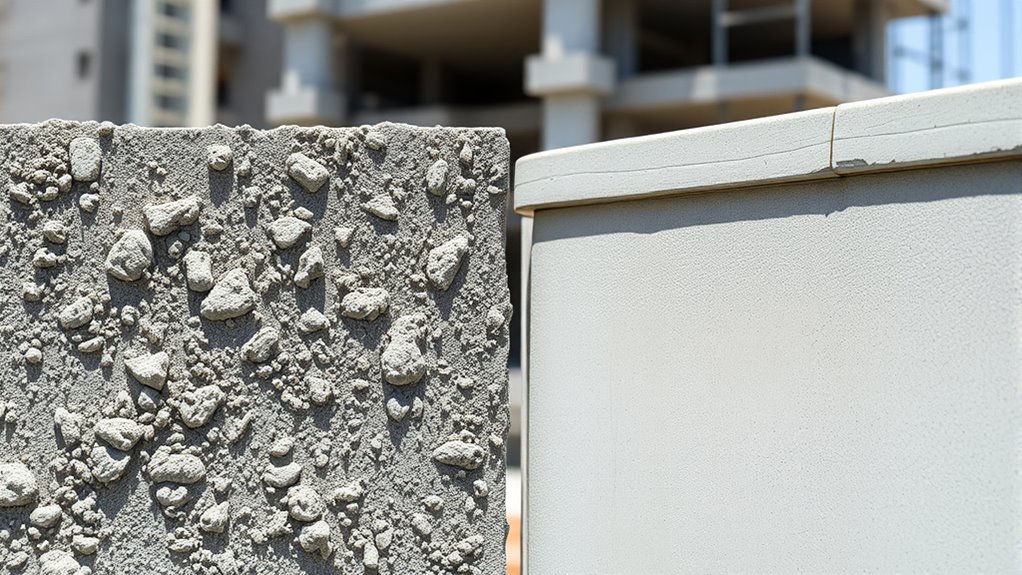
Shotcrete and gunite differ markedly in their composition and materials, which impacts their application and performance. Gunite is a dry-mix process, where you combine cement, sand, and water on-site, then spray the mixture through a hose. It relies on the pressure of water to hydrate the mix as it’s applied. Shotcrete, on the other hand, typically uses a wet-mix process, where the mixture of cement, sand, aggregate, and water is prepared beforehand and pumped directly through hoses. Sometimes, shotcrete includes additives for enhanced properties like durability or workability. The key difference lies in how the material is prepared and delivered, which influences factors like strength, adhesion, and curing time. Your choice depends on project requirements, with each method offering distinct advantages based on material composition. Additionally, understanding the industry transformations driven by AI automation can help in selecting innovative techniques that improve efficiency and quality.
Application Techniques and Equipment Used

The application techniques and equipment used for shotcrete and gunite differ considerably, affecting how each material is applied and the results achieved. Gunite is manually sprayed through a hose using a nozzle, requiring skilled operators to control the mix’s consistency and placement. It’s typically applied in thicker layers, making it ideal for pools or structural repairs. Shotcrete, on the other hand, is pneumatically sprayed with specialized equipment that delivers the material at high velocity, allowing for more precise placement and better adherence to complex shapes. Modern shotcrete machines can be automated, ensuring consistent application over large areas. Both methods require safety gear and proper mixing, but shotcrete often involves more advanced equipment, which can increase setup costs but improve efficiency and finish quality. Additionally, the noise levels of modern shotcrete and gunite equipment are designed to be quieter, enhancing safety and comfort during application.
Strength, Durability, and Performance Characteristics

Both shotcrete and gunite offer strong, durable, and high-performance qualities that make them suitable for demanding applications. They provide excellent structural integrity, resisting cracking and wear over time. Shotcrete’s ability to be applied at high velocity ensures it bonds tightly, creating a dense, solid surface. Gunite, mixed with fine aggregates, also offers strong adhesion and compressive strength. Both materials can withstand harsh environmental conditions, including water exposure, freeze-thaw cycles, and chemical attacks. Their performance can be tailored through mix adjustments, enhancing flexibility or strength as needed. Additionally, shotcrete’s application method allows for rapid placement in complex geometries, making it versatile for various construction needs. Overall, you can rely on either for long-lasting, resilient structures, whether you’re building retaining walls, tunnels, or swimming pools. Their proven performance guarantees safety and longevity in critical construction projects.
Typical Uses and Project Applications

Both shotcrete and gunite are widely used in construction projects, especially for structural repairs and upgrades. You’ll also find them popular choices for swimming pool installations and underground support in tunneling and mining. Understanding their typical applications helps you choose the right material for your specific project needs. Additionally, some contractors prefer hydrocolloid-like moisture-retentive properties in certain formulations to enhance durability in specific environments.
Construction and Structural Repairs
Construction and structural repairs often rely on shotcrete and gunite to quickly strengthen and restore existing structures. If a building’s foundation shows cracks or a wall needs reinforcement, these materials provide fast, durable solutions. Shotcrete and gunite are ideal for patching damaged areas, stabilizing weakened surfaces, or adding support to existing concrete. They bond well with old concrete, ensuring long-lasting repairs. You can use them to reinforce retaining walls, bridge supports, or load-bearing structures. Their versatility allows you to adapt the repair process to various project sizes and complexities. Since both materials can be applied in thin layers, they minimize downtime and disruption. Additionally, the high bonding strength of shotcrete and gunite ensures a secure attachment to existing surfaces, making them exceptionally reliable for structural reinforcement. With proper application, shotcrete and gunite deliver reliable, cost-effective solutions for maintaining structural integrity.
Swimming Pool Installations
When installing a swimming pool, shotcrete and gunite are popular choices due to their strong adhesion and durability. You’ll find these materials ideal for:
- Custom-shaped pools, allowing flexibility in design
- Reinforced structures that withstand ground movement
- Quick application times, reducing construction schedules
- Long-lasting finishes that resist cracking and wear
Both materials bond well with pool finishes like plaster or tile, ensuring a smooth surface. They are suitable for in-ground pools of various sizes, especially when you need a sturdy, watertight shell. Their ability to conform to complex shapes makes them perfect for waterfalls, spa features, or freeform designs. When choosing between shotcrete and gunite, consider project size, budget, and desired finish for ideal results.
Tunneling and Mining Support
Shotcrete and gunite are widely used in tunneling and mining projects to create stable support structures that can withstand extreme conditions. You’ll find these materials lining underground tunnels, shafts, and mining chambers, providing immediate support and preventing collapses. They are especially valuable because they can be applied quickly in confined spaces, reducing project time. Their durability guarantees they resist moisture, rock pressure, and dynamic loads common in mining environments. Whether you’re reinforcing existing tunnels or constructing new ones, shotcrete and gunite offer versatility and strength. They also help control dust and reduce vibrations during application. By choosing the right mix, you ensure long-lasting support, safety, and efficiency in challenging underground conditions. Proper application techniques are essential to maximize the effectiveness of these materials and ensure safety.
Cost and Efficiency Considerations

When comparing shotcrete and gunite, you should consider material costs and how readily supplies are available, as these can impact your budget. Application speed and labor requirements also play a big role in overall efficiency, affecting project timelines. Understanding these factors helps you choose the most cost-effective and efficient option for your needs. Additionally, being aware of Narcissistic behavior and how it may influence project management or teamwork can be beneficial in complex construction environments.
Material Costs and Availability
Material costs and availability play a crucial role in choosing between shotcrete and gunite for your project. Typically, gunite costs more upfront due to the need for specialized equipment and higher labor demands. Conversely, shotcrete often offers more economical options because it’s easier to produce and apply. Consider these factors:
- Gunite requires a dry mix and precise water addition on-site, increasing material handling costs.
- Shotcrete uses pre-mixed or wet mix, reducing onsite prep and material waste.
- Local availability of materials influences overall expenses, with shotcrete ingredients often more accessible.
- Supply chain disruptions can affect costs differently, depending on regional supplier networks.
- Modern shower fixtures and application techniques can also impact overall project costs and efficiency.
Understanding these differences helps you make a cost-effective choice aligned with your project’s material availability and budget constraints.
Application Speed and Labor
Application speed and labor efficiency markedly impact project costs when choosing between shotcrete and gunite. Shotcrete generally sets faster due to its ready-mix nature, allowing you to cover more area in less time. This can reduce labor costs and shorten project timelines. Gunite, which is pneumatically applied, often requires more time for mixing and application, leading to higher labor expenses. If your project demands quick completion or has tight schedules, shotcrete might be more cost-effective. However, gunite’s precision can be advantageous for complex shapes, though it may slow progress. Ultimately, your choice depends on balancing application speed with labor requirements to optimize both costs and project efficiency. Proper application techniques can also influence the overall quality and longevity of the finished structure.
Environmental Impact and Sustainability Aspects
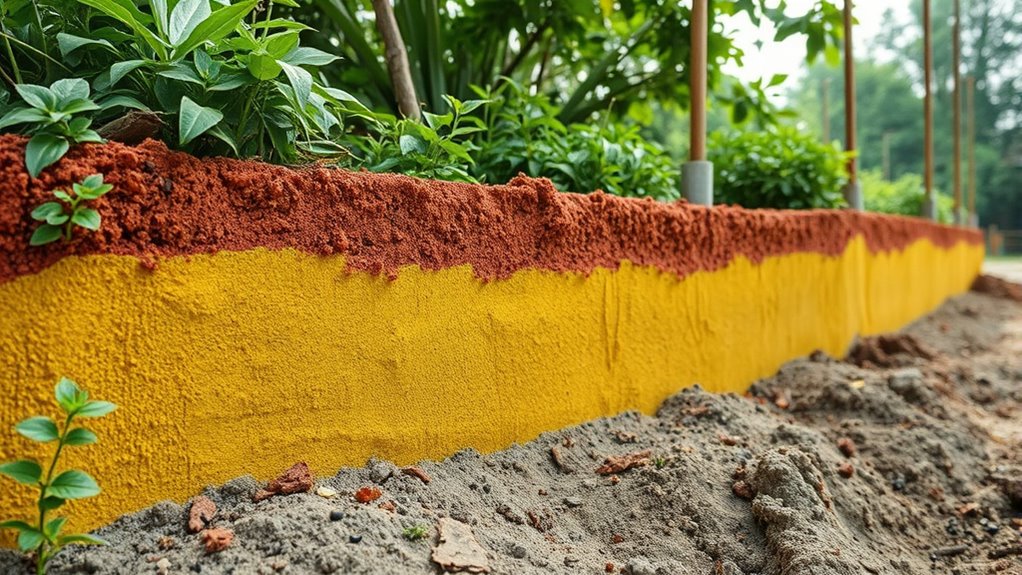
Understanding the environmental impact and sustainability of shotcrete and gunite involves examining their production processes, material efficiencies, and long-term effects. Both methods use cement-based mixes, but differences in application influence their ecological footprint. Shotcrete often requires less material waste due to precise spraying, reducing excess. Gunite’s dry-mix process can result in higher dust emissions if not properly controlled. Both techniques consume significant energy during mixing and application, impacting carbon footprints. Long-term durability minimizes the need for repairs or replacements, promoting sustainability. Additionally, Advanced Techniques in application methods can further reduce resource consumption and environmental impact.
Industry Standards, Certification, and Quality Control

Ensuring consistent quality and safety in shotcrete and gunite projects relies heavily on adherence to industry standards and certification requirements. These guidelines ensure materials, application methods, and testing meet strict quality benchmarks. Certified contractors follow established protocols, reducing risks and improving durability. To help you understand, here’s a quick overview:
| Standard/Certification | Focus Area | Authority |
|---|---|---|
| ASTM C1140 | Material testing and mix design | ASTM International |
| ACI 506R | Shotcrete application methods | American Concrete Institute |
| ICC Certification | Contractor licensing and skills | International Code Council |
| OSHA Regulations | Safety protocols | Occupational Safety and Health Administration |
| Quality Control Programs | Inspection and testing procedures | Industry-specific agencies |
Frequently Asked Questions
How Do Shotcrete and Gunite Compare in Terms of Setting Time?
You’ll find that shotcrete typically sets faster than gunite, mainly because it’s applied through a high-pressure hose that helps it cure quickly. Gunite, mixed on-site, takes a bit longer to set due to its manual application process. Overall, shotcrete’s rapid setting time makes it ideal for projects requiring swift completion, while gunite’s slower process allows for more detailed shaping and adjustments during application.
Are There Specific Safety Concerns Associated With Each Method?
You should be aware that both shotcrete and gunite pose safety concerns if not handled properly. You need to wear protective gear, guarantee proper ventilation, and follow manufacturer instructions to prevent inhaling dust or fumes. You also have to maintain equipment correctly to avoid accidents. Ultimately, staying vigilant, adhering to safety protocols, and receiving proper training help you minimize risks and work safely with either method.
Can Shotcrete or Gunite Be Applied Underwater or in Wet Conditions?
Yes, both shotcrete and gunite can be applied underwater or in wet conditions. You should use special mixes designed for wet application, and guarantee proper equipment to handle the moisture. It’s vital to follow specific techniques for wet shotcrete or gunite, including controlling water content and applying in layers. Hiring experienced professionals guarantees the work is durable and meets safety standards, especially in challenging underwater environments.
What Are the Differences in Surface Finish Quality Between the Two?
You’ll notice that shotcrete typically provides a smoother, more uniform surface finish due to its process of spraying concrete through a hose with compressed air. Gunite, on the other hand, can result in a rougher, more textured surface because it’s applied with a dry mix that’s then watered down on site. If a sleek finish matters, shotcrete usually offers better surface quality, while gunite’s rougher texture can be advantageous for bonding.
How Do Repair and Maintenance Requirements Differ for Shotcrete and Gunite Structures?
You’ll find that repair and maintenance for shotcrete and gunite structures differ mainly in application and surface properties. Shotcrete often requires more frequent repairs because its surface can be less uniform, making it prone to cracking. Gunite, with its more controlled application, tends to need less maintenance and easier repairs. Regular inspections and timely crack sealing help extend the lifespan of both, but gunite generally offers easier ongoing upkeep.
Conclusion
Understanding shotcrete and gunite is like revealing two keys to a sturdy fortress—you’ll find each has its unique rhythm and strength. Whether you’re building a towering wall or a delicate sculpture, knowing their differences helps you choose the right tool for the job. Think of it as choosing the perfect brush for your masterpiece; with the right knowledge, your project will stand tall and last for generations.
